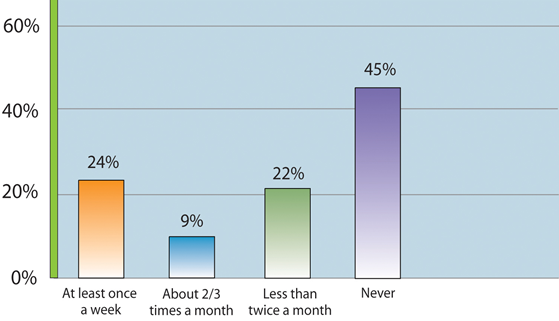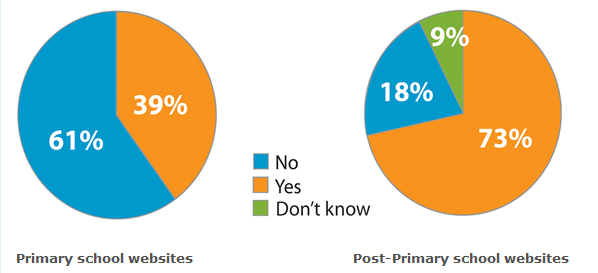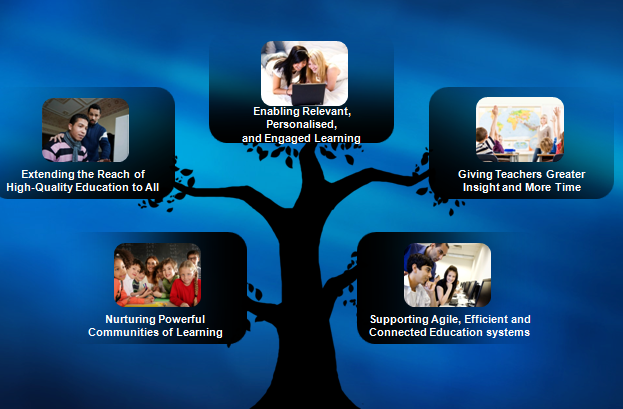Abstract
Globalization and technological change has created a new global economy which is powered by information and communication technology. Information and communication technology have become the basis for educational reform. This paper discusses ‘The use of information and communication technology in education’. Information and communications technology transforms the conventional educational system to a more modern and a better quality system. Information and communication technology helps transform the educational system in several ways. According to Cox (1997), information and communications technology helps in increasing the motivation levels of the students. Information and communication technology makes use of a combination of things and hence helps students learn faster.
Moreover, through networking information and communication technology can not only reuse the information again and again but this also increases learners motivation and helps students to participate in real world events. Information and communication technology also helps in a faster transfer of knowledge and skills (Intel, 2008). On the other hand ICT also helps in training teachers and instructors. It has been found out that the use of information and communication technology in educational institutions can empower students and hence motivate them to learn. The proper use of information and communication technology can change the teacher centred conventional method of teaching to a more learner centred or student centred learning. Hacking is an important issue in using information and communication technology in education. Equity in the use of information and communication technology is yet another issue in the education system. Information and communication technology supports active and collaborative learning. ICT enhanced learning promotes integrative approach to teaching and learning.
Use of Information and Communication Technology in Education
Introduction
Technological change has been fostered in the past decade due to the increasing use of internet and communication technology. More and more people have started using internet as compares to before. In the first decade of its official beginning or its advent, internet was mainly used for research purposes. Even though almost all of the facilities of internet were present at that time, it was difficult for a common man to use it for quite many reasons. One important reason was the high initial cost of the equipment. On the other hand, only people who mastered UNIX operating system had the privilege of using the internet. However, today with user friendly windows systems and cheaper rates of computer equipments, computers and internet is available to all. In 1989, Tim Berners had tried very hard to make internet accessible to all by making the use of internet easy, however it was really in 1993 when the actual mass use of internet began. (Naughton, 2001)
Globalization and technological change has created a new global economy which is powered by information and communication technology. This technological change has brought serious concerns for educational institutions. Information and communication technology have become the basis for educational reform. This paper discusses ‘The use of information and communication technology in education’. How it represents educational transformations, how this transformation embeds the meaning of change in organizations and what are the pros and cons of such education, are a few questions which will be answered in this paper.
According to the World Bank
“ICTs consist of hardware, software, networks and media for collection, storage, processing, transmission, and presentation of information (including voice, data, text and images” (World Bank, 2003).
Hence in other words it can be said that Information and communications technology is used to create, store and manage information. It includes computers, internet and even radio and television (Blurton, 2002).
Historical background
It was in 1980s when relatively low cost microcomputers were available. Due to this the issue of the use of information and communication technology in education was brought up. In the 1980s, the term microcomputer was used for information and communication technology which was later replaced by IT and then finally ICT. In 1992 e-mails started to become popular and the schools and colleges started to accept it as a quicker medium of information sharing. It was expected that microcomputers will make education more effective. However researches reflect that information and communication technology is merely a supplement to the existing curriculum and cannot fully replace it (RUCST, n.d). However, the governments of the developing nations are constantly trying to raise the educational standards be embedding information and communication technology in the curriculum. For this reason the ‘New Relationships’ plan which was announced in 2004 has suggested the government of UK to share management information nationwide with the help of internet technology (Bromley Information management strategy, 2006).
Information technology and education
Information and communications technology transforms the conventional educational system to a more modern and a better quality system. Information and communication technology helps transform the educational system in several ways. It not only motivates the learner but also facilitates this learning process (Haddad, 2002). The acquisition of basic skills in ICT is relatively easier and lead to a more creative human being.
According to Cox (1997), ICT helps in increasing the motivation levels of the students. It is true that students easily get bored with conventional teaching methods and if new methods of teaching are introduced which make use of ICT, it can definitely increase the motivation level of the students. This change can be noted by the positive effect on the behaviour and skills of the students (Comber, 2002).
Information and communication technology makes use of a combination of things and hence helps students learn faster. For example in a slide show put up with the help of a projector, information and communication technology makes use of text, images, motion and sometimes sound to motivate and pursue the learning process and hence transforms the traditional education system. Moreover, through networking information and communication technology can not only reuse the information again and again but this also increases learners motivation and helps students to participate in real world events. information and communication technology also helps in a faster transfer of knowledge and skills (Intel, 2008).
For example: television programs like sesame street not only helped children learn alphabets and words with the use of text, sound, colours and shapes but was relatively a faster way of learning too. This also motivated children to learn. On the other hand ICT also helps in training teachers and instructors. For example the Cyber teacher training centre (CTTC) developed in Korea provides a better way of vocational training for teachers. This training program helps the teachers to think creatively and bringing new ideas for teaching the students. Moreover, it also saves time as the teachers do not have to gather in a face to face meeting (Jung, 2002).It is essential for the teachers to have technology literacy so that they can impart this knowledge to their students. This includes use of computers, internet, web content and other networking and software programs (United Nations, 2008).
Even with so many benefits the use of ICT in education is not up to standard. According to a survey, the teachers use ICT mainly for word processing purposes rather then bringing in innovative methods of teaching. On the other hand the use of e-mail for contacting parents and information sharing has increased, but yet again needs improvement. The survey also reflected that the use of Information and communication technology in school’s classrooms was also very minimal. The graph below shows the how often IT is used in class. (Amas, 2008).When the respondents were asked how often they use ICT in the class it can be seen that 24% said that at least once a week and there were 45% who said never. This reflects the negligence in case of Information and communication technology use in classrooms.

It was then asked whether these schools had a website. The following pie chart reflects the number of schools having a website. In the primary schools almost 61% did not have website where as in secondary school almost 16%.

It has been found out that the use of information and communication technology in educational institutions can empower students and hence motivate them to learn. The proper use of information and communication technology can change the teacher centred conventional method of teaching to a more learner centred or student centred learning. However, even with so many advantages associated with the use of information and communication technology in education; there are some pedagogical issues too which can impact the education system in a negative way.
Hacking is an important issue in using information and communication technology in education. Students can hack into teacher’s computers and find the examination papers archived or can hack in to each other’s computers to cheat on tests or homework. Teachers who use information and communication technology in their classrooms have noticed that students can lose concentration if they fall prey to any kind of distraction which can come from the use of internet or the simple use of computer. Equity in the use of information and communication technology is yet another issue in the education system. The access to the computers, internet etc should not be favoured and each student should be able to access the ICT facilities equally.
An increase in the costs associated with the installation, damages and repairing can increase with the use of ICT in education. Hence, the biggest disadvantage of using ICT in educational institutions is the increased cost which might be a result of this implementation and might recur in future. Another issue which has been under discussion is the difference between the developed and underdeveloped nations which might result in inequity in the use of ICT in classrooms. Another disadvantage associated with the use of ICT in education is the need for having the same technology at home in order to access the information. This might not be possible for some students and hence traditional teachers believe that computers might never be able to replace teachers. Use of ICT results in decreased interaction of students as they tend to break down into smaller groups in an ICT embedded classroom.
The use in education
Information and communication technology supports active and collaborative learning. It helps the students to manipulate current information which is available at fingertips to remain updated and connect to the world. They can compare themselves with other students all over the world. ICT enhanced learning promotes integrative approach to teaching and learning. As ICT based learning is usually student based, therefore it helps the students to explore and learn rather than just sit and listen to the information being poured to them. The level of information absorbed in and ICT embedded classroom depends on the technology being used. According to Haddad (2002), there are five levels of technology which can be used in a classroom. This is presentation, demonstration, drill, practice, interaction and collaboration.
Here are a few advantages of ICT use in education.
- It not only increases students’ motivation towards studies but also increases the teacher’s enthusiasm to teach (Becta, 1998).
- Increases the c communication effectiveness between pupil and teachers (Becta, 2002)
- Enhanced and frequent feedback from the parents and student help the teachers to increase the motivation of students to study
- Parents can be as more involved in the student activities and can even have virtual meeting with the teachers which can enhance the level of communication (Flecknoe, 2001)
- Material and information can be easily shared by teachers and students
- Students have an increased sense of commitment, achievement and self worth (Cox, 1997)
The following reflects and summarizes the main advantages of using information technology in education.

Conclusion
From the above research it can be concluded that information and communication technology plays a very important role in education. With more use of this in the classrooms, the entire education system can be reformed. The use of information and communication technology helps boost the morale and increase the motivation level of students. Children are always ready to do something new. Introducing new methods of teaching and use of multimedia in classroom will help the students learn more. It is truly said that a picture is better than a thousand words; therefore it will take a teacher sometime to explain a certain phenomenon to children, whereas the use of visual aid will make it easier with a long lasting impact in the minds of the children.
References
Amas (2008). Education and ICT. Web.
Blurton, C.,“New Directions of ICT-Use in Education”.
Bromley information management strategy (2006) ICT in education (administration) development plan (2004-2006). Education and libraries directorate.
COMBER, C., et al., 2002. ImpaCT2: learning at home and school: case studies. ICT in Schools Research and Evaluation Series,No. 8, DfES/Becta. Web.
Cox. J., 1997. Effects of information technology on students’ motivation: final report. NCET.
Flecknoe, M., (2001). The use of virtual classrooms for schoolim provement. BELMAS Annual conference, Newport Pagnell, Web.
Haddad,Wadi D. and Jurich, Sonia (2002),“ICT for Education: Potential and Potency”, in Haddad,W. & Drexler, A. (eds),Technologies for Education: Potentials, Parameters, and Prospects (Washington DC: Academy for Educational Development and Paris: UNESCO), pp. 34-37.
Intel (2008).ICT, Education Reform, and Economic Growth: A Conceptual Framework; Foxit Software Company, 2004 – 2007.
Jung, I.,“Issues and Challenges of Providing Onloine Inservice Teacher Training: Korea’s Experience”; Web.
Naughton, John: A Brief History of the Future: the origins of the Internet, Phoenix, 2001, pages.
RUCST (n.d). Pedagogical aspects of ICT. Web.
United Nations (2008) ICT Competency Standards For Teachers; Competency Standards Modules. By the United Nations Educational, Scientific and Cultural Organization.
World Bank. 2004a. World Bank Development Indicators 2004. Annual Report, Washington DC. Web.